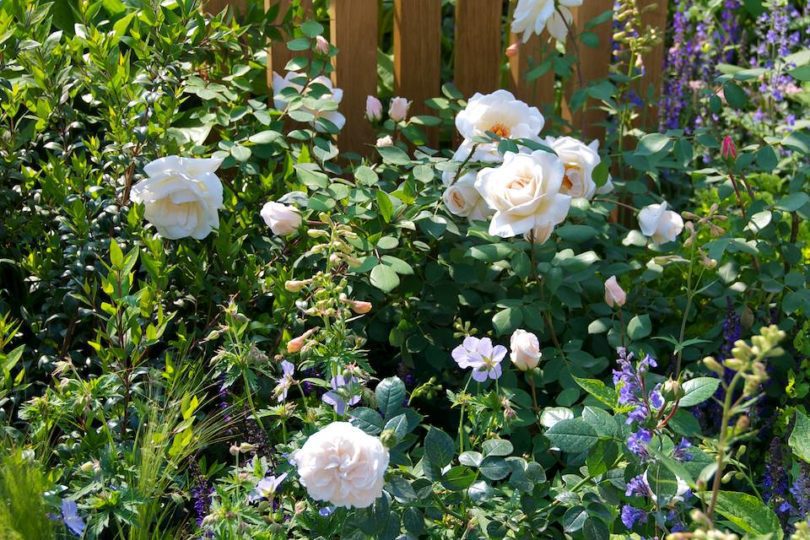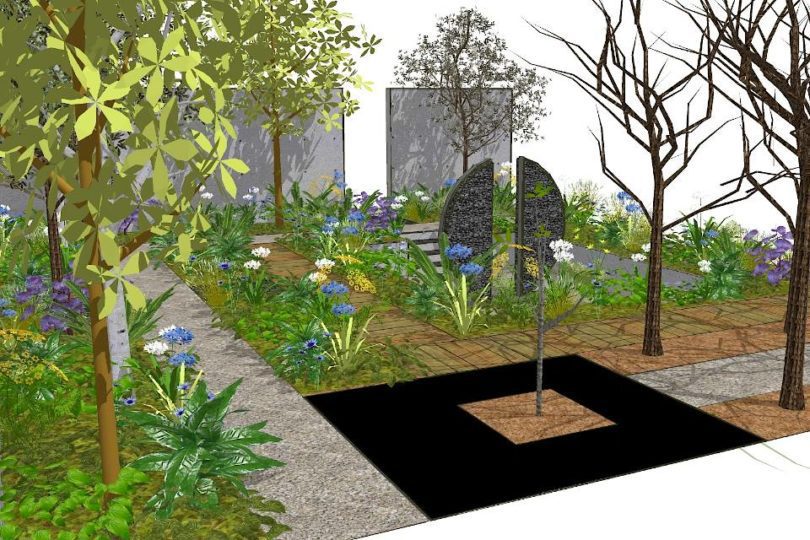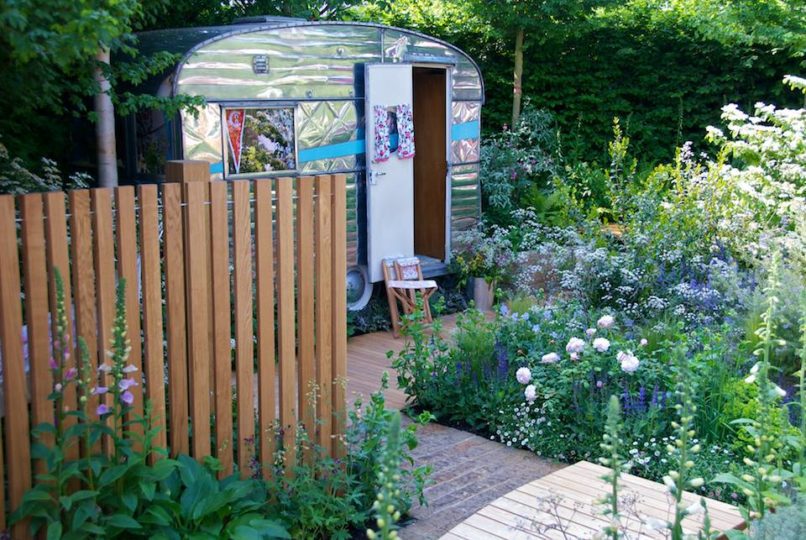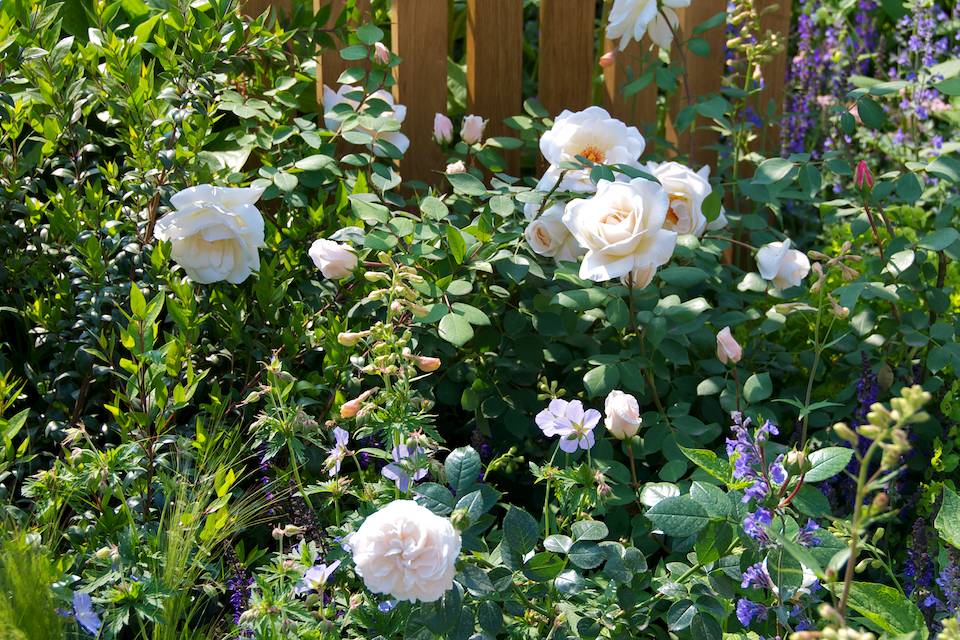She’s back, on Main Avenue with bells on, and the odd dead tree. The award winning garden designer and all round good egg, Jo Thompson is preparing for her return to the RHS Chelsea Flower Show 2013 with a ground breaking show garden, in partnership with the Food and Environment Research Agency (Fera). Thompson brought Chelsea its first Caravan in 2012, and this year her arsenal includes an avenue of dead trees, an ominous pool and a garden that is designed to be both, beautiful as well as ugly. As a garden designer, designing anything ‘ugly’ for the prestige event that is Chelsea, is nothing short of courageous. Come to think of it, kudos are owed to James May for his 2009 plasticine creation….
Thompson’s ‘Stop the Spread’ show garden aims to inspire the public to preserve our horticultural heritage, biodiversity and wildlife by adopting practices to minimise the chances of spreading plant pests, diseases, and/or invasive non-native species. ‘We take our landscapes for granted. Our ancestors nurtured these landscapes in the knowledge that future generations would see them fully grown and mature’, sighs Thompson. ‘I’ve just been to Bedgebury, the national Pinetum to talk to the foresters. They’re working tirelessly to plant trees, that they know they’re never going to see, for which we should not only be grateful, but ensure the trees can thrive’, explains Thompson.
Keen we follow their lead, Thompson went on to explain, that we can all play our part to safeguard our heritage through simple actions, such as for example the careful buying of plants, specimen trees and shrubs from trusted growers, and making sure any unwanted plants are composted carefully and never dumped in the wild.
The good, the beautiful and the ugly
The layout of the 10m by 12m garden, is simple and geometric, dominated by trees, dissected by straight Cedec paths leading to a sunken garden, and includes a pond, sculpture by Tom Stogden and high-performance concrete walls that are patterned by magnified images of pathogens and leaves of invasive plants.







True to the concept, the trees surrounding the show garden are specially selected varieties, that all have a poignant story that we need to be more aware of. ‘They include trees are either under threat, have been under threat, or are potentially under threat’, explains Thompson. Hence, Ulmus minor and Dutch Elm disease; Quercus Robur and Acer campestre, both impacted by Phytophthora; Aesculus indica affected by the Phytophthora and Pseudomonas syringae pathogens; Pinus sylvestris affected by the Fusarium circinatum fungus and Platanus × hispanica under threat of the Ceratocystis platani fungus. ‘Can you imagine London without the London Plane?’, remarks Thompson.
The sunken woodland garden, will be brimming with soft Thomson-esque, herbaceous planting. ‘The colour scheme has taken its cue from woodland plants, blues, whites, and a little bit of lemon, to starkly contrast with the more sinister and shocking elements of the garden’, explains the designer. The soft planting includes some of Thompson’s stalwarts; Geranium, Lychnis flos-cuculi ‘Alba’, Nepeta, various Umbelliferae, Mathiasella bupleuroides, Euphorbia Pasteurii and Ligusticum lucidum, though more will be revealed nearer the event.
Prominently featured at the front of the garden is the avenue of dead Poplar trees, leading to an ominous black pond. ‘When you walk down the avenue of dead trees and you can go no further, you come to the black pond. It looks bottomless, lifeless, to find an oak seedling growing in the middle of it. Contrasting, the scene of death that you’ve walked through, to find life coming through’, explains the passionate Thompson. Originally, the seedling of choice was an Ash, but use of Ash is definitely off the menu, as the RHS explained, ‘In November ’2012, the RHS took part in discussions with DEFRA and agreed a number of measures to help in preventing the spread of Ash dieback disease. One of these measures was to restrict the use of Ash trees at all RHS Shows, as it is considered that there are suitable alternatives which could be used’.
Incidentally, the use of dead trees in a show garden is not without complications. Firstly, one is unable to bring established dead trees into an RHS show, risking the potential spread of concealed pathogens. The trees have therefore been carefully selected and felled from a sustainable forest, and are carefully monitored. Furthermore, there is their fragility in transit to be considered, and that as the trees are felled, they come without roots, making stability an issue. ‘That’s a headache for David Dodd, my contractor’, confirms Thompson. Seeing the legendary and all too amusing Dodd at work in person last year, I’m envisioning some of his serious, trademark pointing and expert directing of staff.
Trees, plants, and that sculpture
Certified ‘clean’ by DEFRA, Thompson’s trees are sourced from Hilliers. ‘Jo’s trees are of approximately 40-45 girth, around the 18 years old’, explained Jim Hillier.
The inclusion of an Elm is a triumph, the result of over 50 years of careful breeding of a hybrid Elm (Ulmus pumila x Ulmus japonica), now resistant to Dutch Elm disease. Work on the hybrid started at Wisconsin University in America in the 50s, and the resultant, saplings were injected with the fungus that causes Dutch elm disease and over much time and research, showed resistance’. The so called ‘resista’ Elms, were brought to the European market, governed Conrad Apple nursery in Germany, for further research and trials. As a trademark programme, breeding and distribution is carefully organised, where all the trees are bred in Germany, and distribution assigned to specific nurseries across the continent. Hilliers are assigned as sole UK supplier of the ‘New Horizon’ Elms. ‘The trees come over to us as, four year old trees and all are micro-chipped, so that the breeding programme, and research continues. If anything did happen they can, trace which batch they came from’, explained Hillier. Don’t even think of taking a cutting, or the Polizei will certainly come knocking.
Hillier went on to explain that the New Horizon Elms now grace the Olympic Park, and they’ve had the trees for over 15 years. ‘They’re really good. It took a while for people to get used to specifying Elm again, and so, it’s still not very widely specified. But where people have taken the plunge, they’re happy’, confirms Hillier.
Thompson’s plants are being sourced from Kelways. Incredibly, Kelways are one of the Chelsea exhibitors that have consecutively, exhibited at the show since the inaugural Chelsea Flower Show in 1913. For Thompson, an estimated 3000 Kelways perennials will be on show. ‘Kelways are fabulous. I have always wanted to work with them’, expresses Thompson.
Tom Stogdon, a frequent Chelsea exhibitor, is creating a bespoke piece for the garden. ‘It’s a large sculpture of circular steel frame, filled with thousands of little pieces of tumbled slate that he painstakingly puts in one by one’, explains Thompson. Split in half, the Stogdon’s masterpiece, will frame select parts of the garden, and allow one to walk through it. ‘Thank goodness it’s on loan, the budget would never have allowed for it’, confirms Thompson.
Return to Chelsea
The much reported Chelsea jitters, including Thompson’s legendary nightmare of Andy Sturgeon’s design including a life-size galleon made of Playmobil, are back it seems, despite this being her fourth return to the show. ‘Being at Chelsea last year doesn’t help at all, it’s a totally new garden. In fact, I’m more scared about the plants not having any light for weeks, and the impact of the extremely cold weather we’ve been having’, sighs Thompson. A sentiment, surely felt by all fellow designers, nurseries and Chelsea exhibitors alike.
‘The team though is everything’, beams Thompson. Apart from a few new additions, Team Thompson, is very much the 2012 team. David Dodd’s talented Outdoor Room contracting team is on board, and the planting team, managed by Nina Baxter includes; the super nimble Yuko Tanabe; the expert planter Kate Carr; the charming Rosie Nottage; the stealth biscuit consuming Serena Craig-Harvey, and yours truly. ‘I am so lucky. It’s such a lovely and wonderful group of people’ explains Thompson. ‘For this job, you have to feel comfortable with the people you work with and know that they’ll be on hand to help you do what you’re hoping to achieve’, she added.
Here’s hoping she’s stocked up on biscuits….
